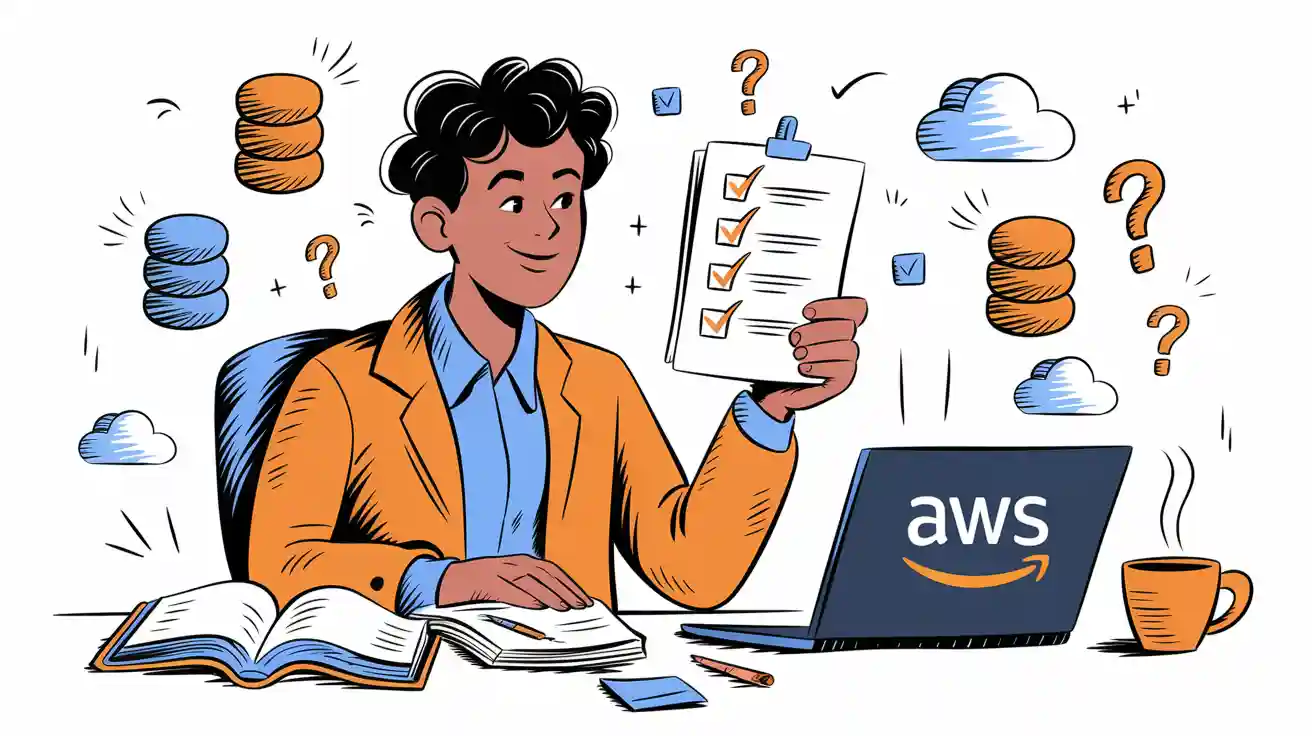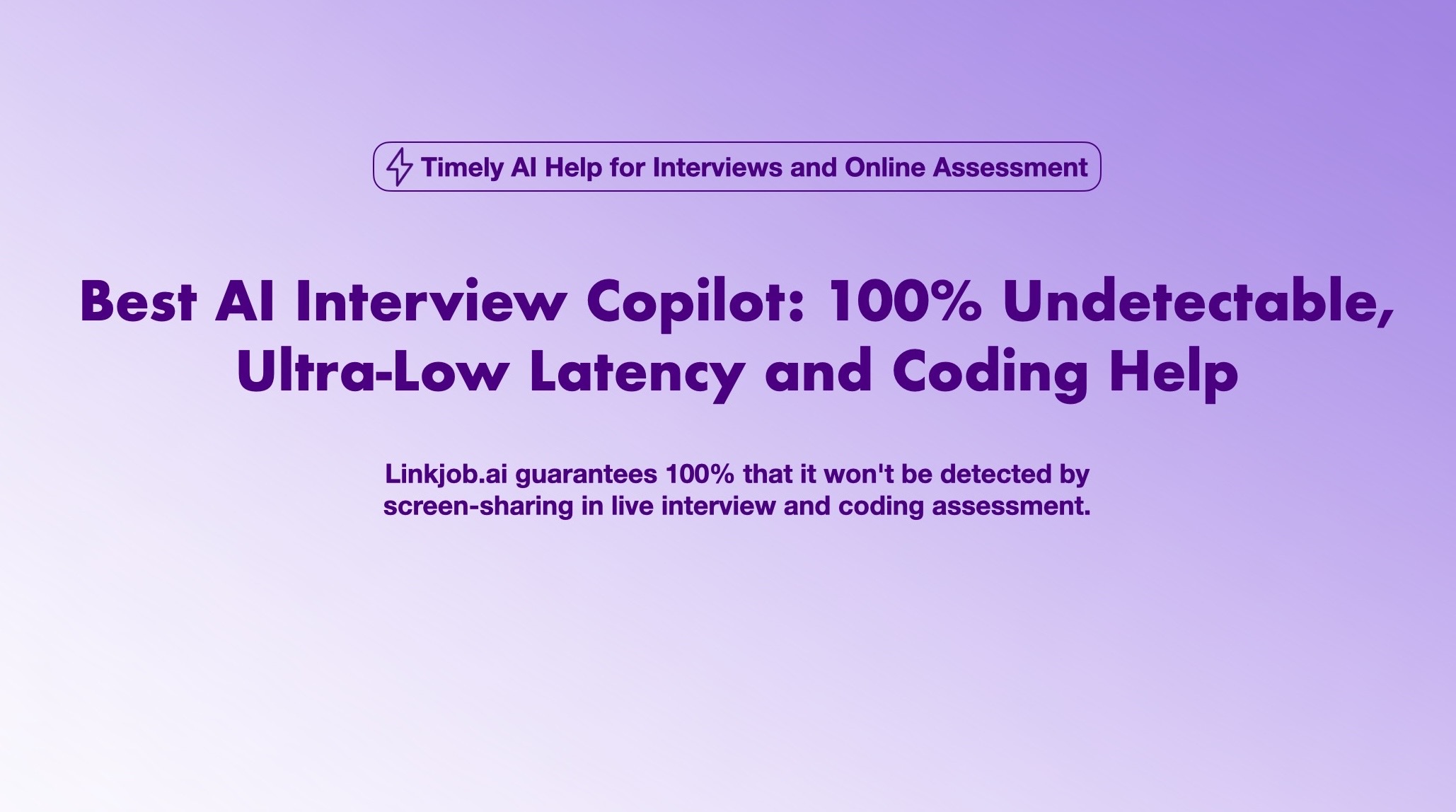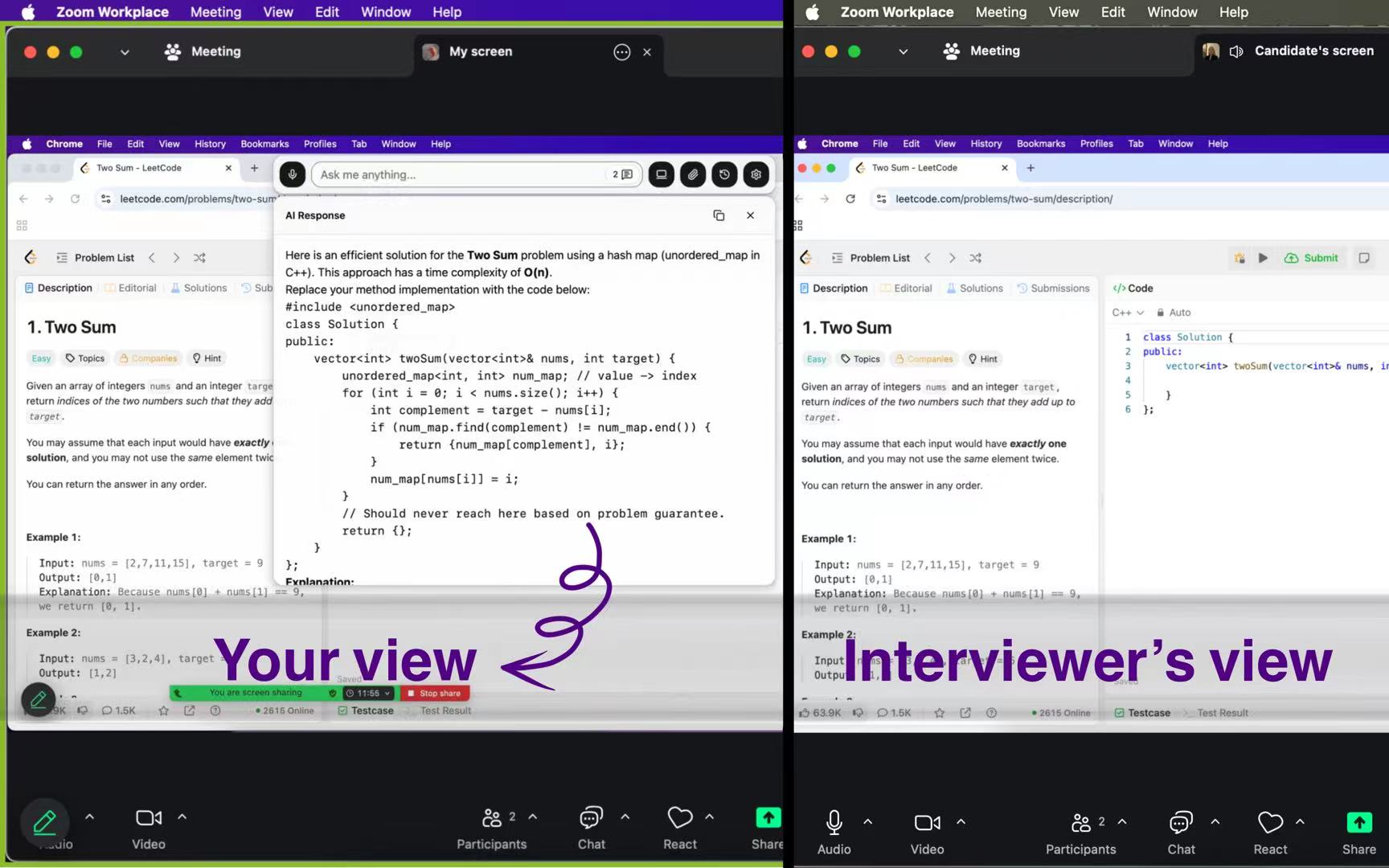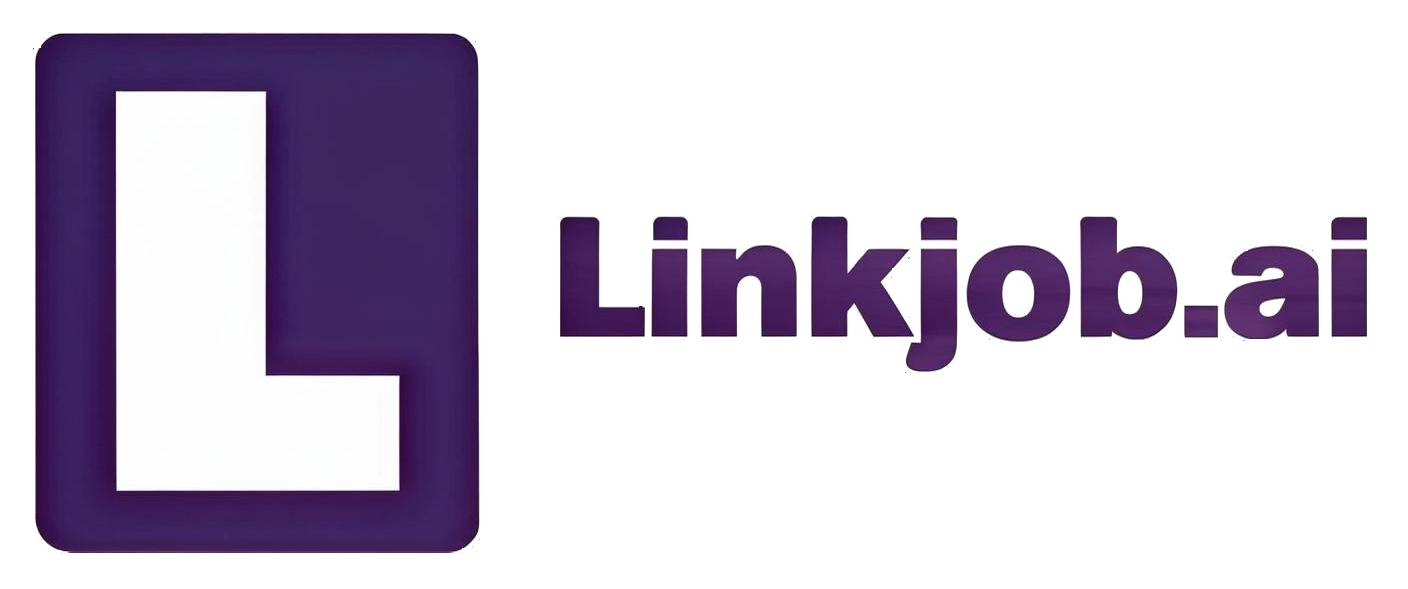My Brutally Honest AWS RDS Prep That Actually Got Me Hired in 2025

I cracked my AWS RDS interview by practicing with real AWS interview questions and answers. I know how tough it feels when you get nervous or freeze on unexpected AWS RDS interview questions. Sometimes, I struggled to find feedback or improve my answers. What helped me most was using tools that let me practice AWS interview questions in a real setting. With the right practice and support, I walked into every interview with confidence and passed.
I have to say, Linkjob.ai is really incredibly useful. During the interview process, it's completely invisible—even if the interviewer requires screen sharing, the other party can't see at all that I'm using AI.
AWS RDS Interview Basics
What is RDS?
When I first started preparing for aws rds interview questions, I realized that understanding the basics of rds is key. Amazon rds is a managed relational database service from aws. It helps me set up, operate, and scale a database in the cloud without worrying about the heavy lifting. I don’t have to handle hardware, patching, or backups. AWS takes care of those tasks. I just focus on my data, access, and performance. This shared responsibility model makes it easier for me to manage my sql databases and run queries without stress. When I want to create a new rds instance, I can do it with a few clicks or commands. That’s why so many companies use amazon rds for their cloud database needs.

Key Features of RDS
When I look at the top features of amazon rds, I see why it’s so popular in aws rds interview questions. Here are the features that stand out to me:
Quick and easy setup with preconfigured settings. I can create a new rds instance in minutes.
Fully managed service that supports six major database engines.
Automated tasks like patching, backups, and failover. I don’t have to worry about missing a backup or a patch.
Easy to move instances between regions or Availability Zones. This helps with disaster recovery.
Dedicated hardware clusters in aws data centers for reliability.
High availability with Multi-AZ deployments and automated failover.
Strong security with VPC isolation, IAM authentication, and encryption.
Flexible scaling options, both vertical and horizontal.
Read replicas to boost read throughput for heavy sql query loads.
SSD-backed storage for fast performance.
Tip: In my experience, mentioning these features in aws rds interview questions shows that I know both the technical and practical sides of rds.
Supported Database Engines
One of the most common aws rds interview questions is about supported database engines. Amazon rds supports seven engines:
Amazon Aurora (compatible with MySQL and PostgreSQL)
MySQL
MariaDB
PostgreSQL
Oracle
Microsoft SQL Server
Amazon rds on AWS OutPosts (for on-premises use)
I often get asked which engine I prefer and why. I usually talk about how MySQL and PostgreSQL are great for open-source projects, while Oracle and SQL Server work well for enterprise needs. Aurora is growing fast and offers high performance. When I create a new rds instance, I always choose the engine that fits my application’s requirements and the type of sql queries I plan to run.

RDS vs EC2 Databases
I remember getting this question in almost every aws rds interview. Should I use amazon rds or run a database on an EC2 instance? Here’s how I explain it:
With rds, aws manages the database for me. I get automated backups, patching, and monitoring. I can create a new rds instance quickly and scale it as needed.
With EC2, I install and manage the database myself. I have more control but also more responsibility. I handle patching, backups, and failover.
Rds is great when I want to focus on my application and not on database maintenance. EC2 is better if I need custom configurations or unsupported engines.
Note: In aws rds interview questions, I always mention that rds saves time and reduces operational overhead, while EC2 gives me full control.
RDS Instance Classes
Choosing the right instance class is a big part of working with amazon rds. I always get questions about which instance to pick for different workloads. Here’s a table that helps me remember the main types:
Instance Class | CPU (vCPUs) Range | Memory Range | Storage Type | Networking Performance | Typical Use Cases and Notes |
|---|---|---|---|---|---|
Burstable Performance | 1 to 8 | 1 to 32 GiB | EBS-only | Low to Moderate (up to 5 Gbps) | Good for workloads with occasional CPU spikes; db.t2, db.t3, db.t4g |
General Purpose | Up to 96 | Up to 384 GiB | EBS-optimized, some with NVMe SSD | Up to 200 Gbps | Balanced for most workloads; db.m5, db.m6g, db.m7g |
Memory Optimized | High | Up to 3.8 TiB | NVMe SSD | Up to 100 Gbps | For memory-heavy apps; db.r5, db.r6g, db.x1e, db.z1d |
Optimized Reads | Moderate to High | Moderate to High | Local NVMe SSD | Up to 200 Gbps | Read-heavy workloads; db.r6gd, db.r6id |
Storage Optimized | High | Up to 1.5 TiB | NVMe SSD | High throughput | I/O intensive apps; db.i3, db.i3en |
When I prepare for aws rds interview questions, I make sure I can explain which instance class fits a specific workload. For example, I use burstable classes for dev or test environments, general purpose for most production apps, and memory optimized for analytics or big data. Every time I create a new rds instance, I match the instance class to my database’s needs and the type of sql queries I expect.
AWS RDS Interview Questions: Security
Data Encryption in RDS
When I get aws rds interview questions about security, I always start with encryption. Amazon rds protects my data at rest by using AWS Key Management Service (KMS). This means all my database storage and snapshots stay safe, even if someone gets access to the storage. For data in transit, amazon rds uses SSL/TLS connections. I connect to my database using encrypted channels, so no one can read my data as it moves. AWS Certificate Manager helps manage these SSL/TLS certificates. I always mention these points when answering questions about security best practices for rds.
Encryption Type | How RDS Protects Data |
|---|---|
At Rest | AWS KMS encryption |
In Transit | SSL/TLS connections |
IAM Integration
IAM integration often comes up in aws rds interview questions. I use AWS Identity and Access Management (IAM) to control who can access my rds databases. Instead of static passwords, I generate short-lived authentication tokens. These tokens last only 15 minutes and work as passwords. My apps or Lambda functions call AWS SDKs to get these tokens. This method keeps my database safer because I do not store passwords anywhere. I also use IAM roles and policies to decide who can connect to my rds instance.
Securing RDS Access
Securing access is one of the best practices for rds. I always place my rds instances in private subnets. This keeps them away from public internet threats. I avoid public DNS exposure and change default ports to make attacks harder. I enable encryption at rest and in transit. I also turn on IAM authentication and manage security groups carefully. I use CloudWatch Logs to monitor access and enable deletion protection to avoid mistakes.
Tip: Following security best practices for rds helps me pass tough aws rds interview questions and keeps my database safe.
RDS Security Groups
RDS security groups act like firewalls for my database. I set rules for which IP addresses and ports can reach my rds instance. These groups are stateful, so if I allow incoming traffic, the response goes back automatically. I keep my rules strict and only open the ports I need. I also use network ACLs for extra protection. For example, I let only my app servers talk to my database on the right port.
Auditing and Compliance
When I get questions about compliance, I talk about how amazon rds supports many standards like GDPR, HIPAA, and PCI DSS. I enable logging and use CloudWatch and Athena to review audit logs. For PostgreSQL, I turn on pgaudit to track changes. I use tools like Amazon Macie to find sensitive data. These steps help me meet industry rules and answer aws rds interview questions about compliance with confidence.
Performance and Monitoring
Monitoring RDS
When I want to monitor the performance of an rds instance, I always start with the built-in tools from aws. I check metrics like freeable memory, I/O performance, disk queue depth, and CPU utilization. These numbers help me spot problems before they get serious. For example, if I see high write latency or a long disk queue, I know my rds instance might need more IOPS or a bigger disk. I also track database connections to make sure my app does not overload the server. Sometimes, I use RDS Proxy to keep connections smooth and avoid sudden spikes. By watching these metrics, I can monitor the performance of an rds instance and keep my sql queries running fast.
Tip: I set up CloudWatch alarms for key metrics. This way, I get alerts if something goes wrong with my rds instance.
Performance Insights
Performance Insights from aws gives me a clear view of what is happening inside my rds instance. I use it to monitor the performance of an rds instance and see which sql queries slow things down. The dashboard shows me database load, CPU usage, and wait events. I can spot slow queries and see if they need better indexing or a different structure. Over time, I look for trends and set baselines. If something changes, I know where to look first. Performance Insights helps me tune my sql queries and keep my rds instance healthy.
Optimizing RDS Performance
I always follow the best practices from aws to get the most out of my rds instance. First, I right-size my instance based on CloudWatch metrics. I tune backup settings to save storage. I combine databases when possible and use multi-tenant setups. Aurora Serverless v2 helps with automatic scaling for changing workloads. I use Performance Insights and query logs to find slow sql queries. Proper indexing makes a big difference. For read-heavy apps, I add read replicas or caching with ElastiCache. I also review my rds instance regularly and remove unused resources. These steps help me keep my sql queries fast and my costs low.
Parameter Groups
Parameter groups let me fine-tune how my rds instance works. I adjust settings for memory, cache size, and sql query limits. If I need to change how my database handles connections or timeouts, I update the parameter group. This gives me control over performance without touching the app code. I always test changes in a dev environment before applying them to production.
Storage Scaling
Scaling storage in aws rds is simple. For Aurora, storage grows automatically from 10 GB up to 64 TB. Standard rds lets me scale storage up to 6 TB with no downtime. I pick the right storage type for my workload—General Purpose SSD for most apps, Provisioned IOPS for heavy transactions, and avoid magnetic disks. The table below helps me choose:
Storage Type | Description | Notes |
|---|---|---|
General Purpose SSD | Good for most workloads | Scales with storage size |
Provisioned IOPS SSD | High throughput, low latency | For heavy sql transactions |
Magnetic (HDD) | Old style, not recommended | No autoscaling, slow |
When I need more compute or memory, I can scale my rds instance up to 32 vCPUs and 244 GiB RAM. I always plan scaling ahead to avoid surprises during peak times.
High Availability and Recovery
Multi-AZ Deployments
When I want my database to stay online, even if something goes wrong, I always enable multi-az deployments. This setup in rds gives me a primary instance and at least one standby instance in a different Availability Zone. Data gets copied instantly between them. If the primary fails, rds promotes the standby to primary. My app keeps working because the endpoint stays the same. I have tested failover in the aws console, and it really is smooth. For any mission-critical app, I make sure to enable multi-az deployments. This is one of the most common aws rds interview questions, so I always mention how it boosts reliability.
Synchronous data replication across zones
Automatic failover with minimal downtime
No need to change application settings during failover
Ideal for high-availability needs
Backups and Snapshots
Backing up an rds instance is something I never skip. Amazon rds gives me two ways: automated backups and manual snapshots. Automated backups run every day and keep transaction logs, so I can use point-in-time recovery for an rds instance. I set the retention period from 1 to 35 days. Manual snapshots are great for long-term storage or compliance. When I need to restore, I just pick a time and rds creates a new instance. The process of backing up an rds instance is simple in the aws console. I always check that backups are enabled before making big changes.
Read Replicas
Read replicas help me scale my rds instance for heavy read traffic. I use them to offload queries from the main instance. I can create up to five read replicas, even in other regions. This helps with disaster recovery and global apps. Replication is asynchronous, so sometimes there is a lag. I keep this in mind when routing read requests. If needed, I can promote a replica to a standalone instance.
Feature | Benefit |
|---|---|
Offloads read traffic | Improves performance for read-heavy apps |
Cross-region support | Helps with disaster recovery and scaling |
Asynchronous | May cause replication lag |
RDS Failover
Failover is a lifesaver when my primary instance goes down. With enable multi-az deployments, rds automatically switches to the standby instance. My app keeps running, and I do not need to change anything. I have seen this work during maintenance and unexpected outages. The process is seamless, and downtime is minimal. I always test failover before going live.
Disaster Recovery
For disaster recovery, I use several aws tools. I automate the process of backing up an rds instance with AWS Backup and Lambda. I also set up cross-region read replicas for extra safety. Regularly, I test my recovery plan by promoting replicas and restoring from backups. I use point-in-time recovery for an rds instance to get back to a specific second if needed. I always document my steps and keep my team ready for any event.
Tip: Always enable multi-az deployments and automate the process of backing up an rds instance. Use point-in-time recovery for an rds instance to minimize data loss.
Migration and Maintenance
Database Migration to RDS
Migrating to rds can feel overwhelming, but I found that aws makes it much easier. The most common way I move data is with AWS Database Migration Service. I usually start with a full load, which copies all my data to the new rds instance. After that, I switch to Change Data Capture mode. This keeps my new rds instance in sync by copying any changes from the old database. I once helped an ecommerce team move their MySQL database to rds over a weekend. We used full load first, then CDC, and the final cutover took just seconds. Planning ahead and monitoring the migration helps me avoid surprises.
AWS DMS Overview
AWS DMS is my go-to tool for migrations. It supports many engines, like Oracle, SQL Server, MySQL, and PostgreSQL. Here’s how I usually set it up:
I define my source and target endpoints, making sure aws dms can connect to both.
I launch a replication instance, which does the heavy lifting.
I create a migration task, often using full load plus CDC for minimal downtime.
I monitor progress in the aws console and CloudWatch.
Component | What It Does |
|---|---|
Source Endpoint | Connects to my old database |
Replication Instance | Moves data between source and rds |
Migration Task | Sets how data moves (full load, CDC, or both) |
Target Endpoint | Connects to my new rds instance |
Upgrading RDS Instances
When I need to upgrade an rds instance, I always plan for minimal downtime. I create a green environment that matches my production instance but uses the new version. I test everything there first. When I’m ready, I switch traffic from the old (blue) instance to the new (green) one. This method keeps downtime under a minute. For minor upgrades, I enable auto-updates in aws. I schedule these during maintenance windows to avoid user impact.
Maintenance Without Downtime
I like that aws lets me schedule maintenance for my rds instances. I pick a weekly window that works for my team. Multi-AZ deployments help a lot here. Updates happen on the standby instance first, then aws fails over, keeping downtime under a minute. I check pending maintenance in the aws console and can defer or apply updates as needed.
Tip: Always use Multi-AZ for production rds instances. It keeps your app running during maintenance.
Troubleshooting RDS
When something goes wrong with an rds instance, I start by checking CloudWatch metrics. I look for CPU spikes, storage issues, or connection errors. The aws console shows pending maintenance or alerts. If I see slow queries, I use Performance Insights to dig deeper. Sometimes, a quick reboot or failover fixes the problem. I always keep backups and snapshots handy, just in case I need to restore the instance.
Preparation Tips for AWS RDS Interview
Hands-On Practice
When I started preparing for my aws rds interview, I realized that nothing beats hands-on practice. I spent time in the AWS console, creating and managing rds instances. I tried different database engines and played with settings like Multi-AZ deployments and read replicas. Running real sql queries helped me understand how rds works in action. I also used the AWS CLI and SDKs to automate tasks. This gave me confidence to answer technical questions and explain my process during the interview.
Tip: Practice creating backups, restoring from snapshots, and scaling storage. These are common aws interview questions that show you know your stuff.
Reviewing Core Concepts
Before any interview, I always review the core concepts that come up in aws rds interview questions. Here’s what I focus on:
The six supported database engines and their use cases.
How to set up high availability with Multi-AZ deployments.
Backup and recovery steps, including point-in-time recovery.
Monitoring and tuning performance with CloudWatch and Performance Insights.
Using parameter groups to fine-tune database behavior.
Setting up read replicas for scalability.
Security best practices like encryption and IAM roles.
Running basic sql commands: create, update, delete, and aggregate data.
Automating tasks with Lambda and CloudWatch Events.
Migrating databases using AWS DMS.
I make sure I can explain each concept clearly and give real examples in my answers.
Mock Interviews with Linkjob
I used to get nervous before interviews, especially when I didn’t know what questions would come next. Practicing with Linkjob changed that for me. Linkjob gives me mock interviews that feel just like the real thing. The AI asks tailored aws rds interview questions based on my resume and the job description. It listens to my answers and follows up with new questions, just like a real interviewer. I get instant feedback on my answers, including tips on how to improve my delivery and structure. Practicing with Linkjob helped me stay calm, answer unexpected questions, and build my confidence for the big day.
Avoiding Common Mistakes
I learned to avoid some common mistakes that can trip up even the best candidates. I don’t just memorize answers—I practice explaining my thought process. I always double-check my sql syntax and make sure I understand the question before I answer. If I get stuck, I take a breath and think about similar problems I’ve solved. Practicing with realistic mock interviews helps me spot weak areas and fix them before the real interview. I also review feedback after each session to keep improving.
Tired of Studying AWS RDS the Hard Way With No Real Results?
I stopped wasting time with scattered prep and started training with Linkjob. It gave me targeted AWS RDS mock interviews, real-time feedback on weak spots, and smart suggestions even during the actual interview. If you’re aiming for a cloud role in 2025, this is the shortcut that actually works.
Real-Time Support in AWS RDS Interview
Handling Unexpected Questions
During my first big aws rds interview, I remember getting a question I had never seen before. My mind went blank. I had practiced so many aws interview questions, but this one felt different. Sometimes, interviewers ask questions that test how I think, not just what I know. They might ask about a tricky rds instance failure or a new aws feature. When this happens, I try to stay calm and break the question into smaller parts. I focus on what I do know about rds and aws. I share my thought process out loud. This shows the interviewer that I can handle tough questions, even if I do not know the perfect answers right away.
Staying Composed Under Pressure
Interviews can feel stressful, especially when I want to give the best answers. If I get stuck, I pause and take a deep breath. I remind myself that it is okay not to know every detail. I use what I have learned from hands-on practice with rds and aws. I talk through my logic and explain how I would solve the problem. This helps me stay focused and confident. I have noticed that interviewers like it when I show how I approach questions, not just when I give quick answers.
Leveraging Real-Time AI Support
One thing that changed my interview game was using Linkjob’s Real-Time AI Interview Assistant. This tool listens during my live interview and gives me smart answer suggestions. If I get a hard aws interview question about an rds instance or a new aws feature, Linkjob helps me find the right words. It understands the context and gives feedback based on my resume and the job description. I feel more prepared for any questions, even the ones I did not expect. Linkjob works great for tech and finance interviews because it knows the details that matter. With real-time support, I can recover quickly and give strong answers, no matter how tough the interview gets.
FAQ
What types of AWS RDS interview questions should I expect?
I usually see a mix of technical and scenario-based questions. Some focus on RDS basics, while others test my problem-solving skills. I always prepare for questions about security, performance, and real-world troubleshooting.
How do I handle tricky questions during an interview?
When I get tough questions, I pause and think out loud. I break the problem into smaller steps. If I do not know the answer, I explain my approach. This shows the interviewer how I solve problems.
Can I practice AWS RDS interview questions online?
Yes! I use online platforms like Linkjob to practice real interview questions. These tools give me instant feedback and help me improve my answers. Practicing with mock questions boosts my confidence.
How many questions do interviewers usually ask about RDS?
In my experience, interviewers ask around 5 to 10 questions about RDS. The number depends on the role and the depth of knowledge required. I always prepare for follow-up questions, too.
What should I do if I do not know the answer to a question?
I stay calm and share what I do know. I talk through my thought process and relate it to similar questions I have answered before. Interviewers like to see how I handle unknowns.
Tip: Practicing a wide range of questions helps me feel ready for anything.

